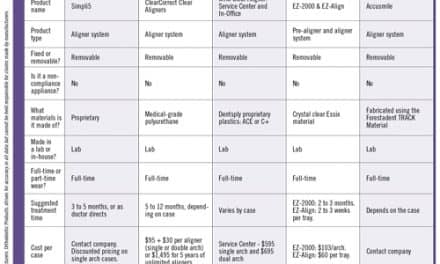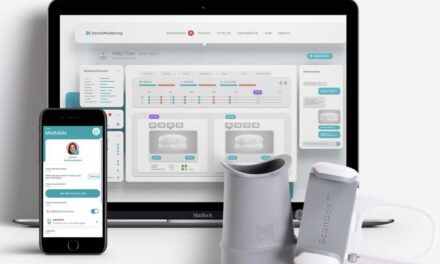by Michael J. Berkowitz, Esq
Basic patent law for the inventive orthodontist
 |
Have you ever thought of a unique method for treating your patients or a device that would benefit your patients? Have you ever thought of a new product that would make life for other orthodontists easier? If so, imagine how nice it would be if you could be paid for your ingenuity. The best way to capitalize on your creativity is to obtain a patent for your invention. Many orthodontists and other professionals in this industry have been doing this for years, and very successfully.
The art and science of orthodontics has advanced significantly since the days of Angle, due in part to the protections provided by patents. This article will discuss the basics of how to obtain a patent, as well as other issues commonly faced by orthodontists with inventive ideas.
In 2007 alone, more than 50 patents were issued that used the word “orthodontic” in their title. Among these 50 were utility patents covering self-ligating orthodontic brackets (US Patent No. 7,210,927); hinged orthodontic brackets (US Patent No. 7,210,928); thermoplastics used in orthodontics (US Patent No. 7,186,115); and how to assess the outcome of an orthodontic treatment (US Patent No. 7,160,107). Orthodontists and others in the industry have come to recognize the value of patents as a means for protecting their inventions and generating revenue streams.
What is a patent?
 |
| Michael J. Berkowitz, Esq |
A patent is a set of exclusive rights, granted by the federal government, that give an inventor the right to exclude others from practicing the invention described and claimed in the patent. In the United States, three types of patents are available: 1) a utility patent, which covers the functional aspects of products and processes; 2) a design patent, which covers the ornamental design of useful objects; and 3) a plant patent, which covers a new variety of living plant. Each type of patent provides “the right to exclude others from making, using, offering for sale, or selling” the invention in the United States or importing the invention into the United States. Patents protect certain categories of patentable subject matter. What counts as patentable subject matter is rather broad and includes articles of manufacture, compositions of matter, processes, devices, business methods, software, improvements on existing products, and many other things. In fact, one court described patentable subject matter as “anything under the sun made by man.” At present, the term of a patent is 20 years from the filing date of the patent application. Once a patent expires, or the patent is held invalid, the invention is considered to be in the “public domain.” At that point, the patent owner can no longer stop anyone from making, using, or selling the patented invention, and the public benefits from the technical advancement.
How do I obtain a patent?
In the United States, the first step to obtaining a patent is to file a patent application with the US Patent and Trademark Office (USPTO). Usually, the application is prepared and filed by a patent attorney on behalf of the applicant/inventor. The application undergoes detailed examination by a representative of the USPTO known as a patent examiner. The patent examiner’s job is to decide whether the invention meets the requirements for patentability and whether the content and format of the patent application complies with required formalities. Usually, the application process involves arguments and negotiations between the patent examiner and the patent attorney. On average, it takes about 2 to 3 years for a patent to issue after the application has been filed.
Is my invention patentable?
Patents are granted only for inventions that are novel, nonobvious, and useful.
To meet the novelty requirement, the invention must not have been known or used by others in this country or patented or described in a printed publication anywhere before the applicant invented it. Moreover, if the invention was patented by another or described in a printed publication anywhere more than 1 year before the application date, or if the invention was in public use or on sale in the United States for more than 1 year before the application date, it cannot be patented.
Nonobviousness is often the greatest obstacle an inventor must overcome to obtain his patent. Even if the invention is novel, the patent application may be rejected on the basis of nonobviousness. The nonobviousness requirement is met if the claimed invention is sufficiently different from existing technology and knowledge so that, at the time that it was made, it would not have been obvious to a person having ordinary skill in the particular art to which it pertains. The policy behind the novelty and nonobviousness requirements is that a patent, being a legal monopoly, should be granted only for real advances in the art.
Finally, to meet the usefulness requirement, an invention must have practical utility and work for its intended purpose.
It is a common practice for inventors to have a search conducted prior to filing for a patent application. This search can provide some indication as to whether the invention could be patented, and also whether someone else has a patent that would be infringed by making, selling, or using the invention. Such “preexamination” searches have traditionally been performed by hand at the public search room of the USPTO. However, there is growing confidence in computerized searches, particularly for certain types of high-tech inventions. The USPTO has also made available for searching all US patents and published applications at its Web site, uspto.gov.
If I work for a university or an academic hospital, do I own my invention or does the university or hospital own it?
The general rule is that the inventor owns the patent for his or her invention. If the inventor is the owner of his or her own private practice, ordinarily the inventor owns the rights to the invention and patent. However, where orthodontists are employed by universities or hospitals, the general rule may not apply.
Two more common situations in which the inventor would not own the patent for the invention because of an employment relationship are: 1) there exists an express assignment; or 2) the inventor is considered hired to invent. If the inventor is employed by, or otherwise affiliated with, a hospital or group practice, that inventor should check his or her employment contract. Universities and academic hospitals usually have specific intellectual property (IP) rights provisions in their physician employment contracts or reference these provisions as part of their policies and procedures manual.
If none of these apply, the next question is whether the inventor is considered hired to invent. This is a bit of a gray area, as it depends on the nature of the inventor’s practice. For example, if the practice is purely clinical, then the inventor is arguably not hired to invent. On the other hand, if the inventor’s practice is primarily engaged in research, especially at a university hospital, then the inventor may be hired to invent. Determining early on who owns the rights to an invention is critical. This could help you avoid spending a great sum of money to patent an invention that does not belong to you. Moreover, hospitals and universities will often pay for costs associated with obtaining a patent and commercializing an invention. Many hospitals have IP policies that reward medical professionals with royalties for their patented and commercialized ideas. Such policies often create win-win situations for medical professionals and hospitals.
What is a provisional patent application?
The USPTO offers inventors the option of filing what is called a “provisional application” for patent. A provisional application is designed to provide a low-cost first patent filing in the United States. A provisional application has a pendency lasting 12 months from the date the provisional application is filed. The 12-month pendency period cannot be extended. Therefore, an applicant who files a provisional application must file a corresponding nonprovisional application for patent in the next 12 months in order to benefit from the earlier filing of the provisional application. The nonprovisional application must contain a specific reference to the provisional application. Inventors often utilize the 1-year pendency period of the provisional application to develop commercial interest in the technology disclosed in the application. A provisional application provides the inventor with an early effective filing date for a later-filed nonprovisional patent application, and allows the inventor to apply the term “Patent Pending” to goods or services covered by the provisional patent application disclosure. The USPTO does not examine provisional applications on their merits, and such applications automatically become abandoned on the 1-year anniversary of their filing date. The provisional application does not provide an inventor with any enforceable patent protection for the invention described in the application, unless it is converted into a nonprovisional patent application during the 1-year pendency period.
If I get a patent, how can I make money from it?
|
To read more articles about legal |
Some inventors start new companies to develop and market their patented inventions. The inventor may keep the patent and use it to provide value to his or her business by preventing competitors from making, using, or selling the patented invention. This is not typical, however, because the majority of inventors either don’t have the resources to start a new business or prefer inventing to running a business. More often, an inventor obtains a patent for the invention but makes arrangements with an existing company to develop and market the invention. This arrangement is often referred to as a “license,” which is nothing more than a contract under which the inventor continues to own the patent and a developer is authorized to commercially exploit the invention in exchange for paying the inventor royalties. The royalties may be a percentage of the profits or revenues made on sales. Finally, the inventor may choose to sell all of the rights to the invention for a lump sum, installments, or a combination. This is referred to as an assignment.
Michael J. Berkowitz, Esq, is a registered patent attorney with the law firm Caesar, Rivise, Bernstein, Cohen & Pokotilow Ltd, in Philadelphia. He can be reached at
DISCLAIMER: This article is intended for informational purposes only and is not to be understood as giving legal advice or opinion.





